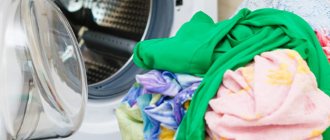The main substance found in silk is the protein fibroin. Therefore, the properties of silk differ from the properties of plant tissues.
One of these differences is sensitivity to mechanical stress and high temperature. Because of this, silk needs proper care, part of which is washing.
If you neglect it, silk fabric will not last long. Let's talk in more detail about whether silk can be washed and how to do it correctly.
How to remove stains from natural silk?
A cotton swab should be moistened with alcohol and carefully, using dipping movements, treat the fabric in the area of contamination. To remove a yellow stain from white silk, you need to rinse the clothes in cool water with the addition of a few drops of ordinary vinegar.
Interesting materials:
How to delete a file if it says that it is open in Explorer? How to delete a file or folder that cannot be deleted? How to delete a file from the Program Files x86 folder? How to delete a file from downloads on Android? How to delete a file that is in use? How to delete a file that is protected by administrator rights? How to delete an administrator permission file? How to delete a file using ccleaner? How to delete a file from your computer desktop? How to delete SYS file?
Can it be washed in a washing machine, at what temperature?
Depending on the production technique, there are 3 types of silk fabric:
- natural;
- artificial;
- synthetic.
To wash silk fabric of any of these varieties, you do not have to go to the dry cleaner. If you follow simple rules, anyone can do this at home.
Natural
Silk is made from fiber produced by the silkworm larva. It is very thin and sensitive, so it is easily destroyed during washing. However, you can still wash silk fabrics.
When washing, it is important to strictly observe the temperature regime (water should not be hotter than 30 degrees) and use auxiliary products that will help not damage the fabric.
Silk fabrics are washed only by hand. Machine washable. After the first session, the canvas loses its original shape due to deformation or rupture of microscopic fibers. It becomes visible damage that looks like small stretch marks or damage to the texture.
Artificial
Artificial silk is obtained from vegetable protein or cellulose. These substances are exposed to acid. As a result, a chemical compound is obtained that is very similar in structure and properties to fibroin.
Therefore, it is also possible to wash items made from artificial silk, as is the case with natural fabrics. The same rules must be followed.
Synthetic
Synthetic silk is understood as a material that is close in properties to natural silk, but is obtained through a chemical reaction using plastics and waste from the oil refining industry. This fabric is also washable.
Washing rules are close to those of natural material . The only difference is a slightly higher water temperature, which is necessary because synthetic silk fabric absorbs sweat and other contaminants better, but is a little more difficult to clean from them.
Despite the fact that artificial or synthetic silk is somewhat stronger than natural and artificial silk, it is not advisable to wash them in a machine. However, in case of heavy soiling, machine washing is still acceptable.
How to dry it?
Since silk fibers are very sensitive to physical stress, they can break even if hung on a clothesline under the weight of wet fabric. Therefore, drying silk items requires a special approach.
To dry the product, lay it out on a flat surface and wait until the moisture has completely evaporated . In this case, it is undesirable for the fabric to be exposed to direct sunlight.
You will find maximum useful information about washing clothes and various fabric products here.
Rules for washing silk products
Washing silk products requires a special approach. First you need to find out what material the item is made from. If we are talking about artificial silk, then you can use white toilet or baby soap. If you need to wash natural silk, then you can use neutral powders and soaps.
To ensure that bed linen or a beautiful silk blouse retains its original properties and does not lose its commercial appearance, you must adhere to the following recommendations:
- before washing, silk items should be soaked in warm water, to which a few drops of colorless detergent are first added;
- the water temperature should not be higher than forty degrees;
- It is best to use boiled water;
- Silk should be rinsed with the addition of a softener and antistatic agent;
- You cannot wring out such fabric;
- It is also not recommended to wash certain areas, otherwise the fabric will be damaged.
When it comes to washing silk items, the most questions that arise are about the choice of water temperature. Usually the manufacturer indicates this information on the tag of clothing or bed linen. If such data is not available, then the temperature may be 40°C. However, if the material tends to shed, then the temperature should not exceed 30°C. The water should not be too hard. To soften it, you can add 10 g of soda per liter of liquid.
Preparing for washing
Washing silk items begins with the preparatory stage. It is as follows:
- Find out how durable fabric dyeing is. To check this, it is recommended to take a piece of cotton fabric. It must be clean and white. Wet this piece with water and run it along the seam of the silk garment from the inside out. You need to place the same material under the product and iron everything with a warm iron. If the white piece remains clean, it means the item will not fade during washing;
- All clothes should be sorted by shade. Clothes made from transparent, thin fabric should be washed separately. Be sure to check all pockets and fasten buttons;
- It has already been noted that silk items cannot be soaked. If there is heavy contamination, it is allowed to leave the product in water, but for no more than 3 minutes;
- Only mild, gentle detergents may be used. Most often they come in liquid form.
How to iron viscose fabric
In conclusion, here are the general rules so that you finally understand how to wash viscose so that it does not shrink, stretch or otherwise lose its shape:
- Viscose fabric, which contains acrylic or wool, should be washed only in cold water, otherwise the item will inevitably shrink 1-2 sizes;
Rule #8. Things made of viscose cannot be worn wet - they will stretch out. For the same reason, they are not dried with vertical steamers.
- If you want to refresh the color of your dress, add a teaspoon of table vinegar (9%) to the rinsing water;
- The polyester content of viscose fabric makes it smooth and shiny. However, the slightest defects are clearly visible on it, for example, puffs, stains, and pellets quickly appear. Such items should be washed by hand or in a machine in a case;
- Wool adds softness to the fabric and is pleasant to wear on the body, but may cause pilling if not washed properly. Before the procedure, clean the item with a sticky roller, remove lint and top dust;
- The addition of elastane allows the material to stretch well, but as a result of incorrect washing and drying, the item can hopelessly lose its shape. Avoid rough spinning and vertical drying;
- Thanks to the cotton content, viscose wrinkles a lot, but smooths out well. This fabric is considered hypoallergenic.
Read on and you will learn how to remove chewing gum from trousers.
Rule #10. As a rule, viscose fabric does not fade, but fades when exposed to sunlight. Moreover, it burns out unsightly - in spots. Dry clothes in a ventilated area with indirect sunlight.
You need to take good care of viscose so that you don’t have to buy a new dress every time.
Therefore, special attention should be paid to drying and ironing. Drying:
Drying:
- It is carried out in a horizontal position. Place the product on a terry towel. Squeeze out excess moisture. Change the towel to a dry one and leave to dry. Turn your clothes over periodically.
- Can be hung on hangers. You just need to use a wooden product. Metal hangers can leave rust on your clothes.
- Fabric wears out faster when exposed to ultraviolet light.
Steaming has a negative effect on the material. It is not recommended to use this function.
- Place washed items on wooden or plastic hangers to drain. You shouldn't take metal ones - they leave traces.
- You can lay out and smooth the product on a plane, so it will definitely not be deformed.
- A towel or folded sheet will help remove excess moisture. The blouse is placed on a towel and rolled up, pressing lightly. This way, deformation will be avoided.
- Heated dryers and washer dryers cannot be used. As well as drying wet things on radiators or the active sun. Exposure of viscose to high temperatures causes deformation and shrinkage.
- To dry, items with a high content of viscose fiber should be smoothed by hand on a flat surface.
Iron any item of clothing or home textiles made from natural cellulose according to the following recommendations.
- The operation should be carried out exclusively from the wrong side.
- Turn the iron on low heat.
- Iron elements and decor on the front side through gauze.
- Do not use a steamer or topical humidification from a spray bottle. Hot steam causes clothes to stretch.
- If moisturizing is necessary, use damp gauze and iron through it.
How to preserve the color of an item?
To avoid loss of color, the washed item is rinsed in a vinegar solution, as mentioned above. However, there are other ways to preserve color. The simplest of them is adding starch to water.
To do this, perform the following steps:
Potato starch is added to water at a temperature not exceeding 30 degrees Celsius at the rate of 3-4 tablespoons per 10 liters of liquid;- they place a silk item there;
- cover the container with the item with a lid and leave it for 2-3 hours;
- the item is taken out and washed using detergents, and then rinsed;
- after the first rinse, prepare a water-alcohol solution at the rate of 1-2 tablespoons of ethyl alcohol per 10 liters of water;
- The item is rinsed in the resulting solution.
Instead of alcohol, you can use vodka. In this case, add 3-4 tablespoons of alcohol to the water.
Also, to preserve or refresh color, special compounds are widely used, which can be purchased at household chemical stores.
Often their use is more effective than using vinegar or starch with alcohol. An example of such compositions is the Woolite line of gels.
Choosing a cleaning product
The best option would be gels and powders marked “Silk”, as well as liquid cleaners for delicate fabrics. Do not use bleaches or stain removers.
Table 1. Detergents for washing silk and delicate fabrics
| Name | Photo | Volume | price, rub. |
| Weasel “Wool and Silk” | 1 l | 180–250 | |
| Meine LIEBE | 800 ml | 225–240 | |
| Wellery | 1 l | 230–250 | |
| BURTI WOLLPFLEGE | 750 ml | 165–180 | |
| "Vorsinka" | 1.2 l | 110–130 | |
| Stork – “Cashmere” | 950 ml | 80–100 | |
| Organic People | 1.5 l | 430–450 | |
| Gel capsules Tide | 12 pcs. | 250 | |
| Ariel capsules | 13 pcs. | 190 | |
| Gel Ariel | 1.3 l. | 400 |
Preference should be given to liquid products and gels. They do not leave white streaks on the canvas, dissolve well in water and can be rinsed out.
When choosing what to wash silk with, you can pay attention to regular gels and gel capsules Tide and Ariel. Due to their soft structure, they do not damage delicate fibers.
Features of hand washing
The optimal solution for caring for silk items is hand washing. Especially when it comes to natural products that require careful handling. It is necessary to fill a plastic container with warm water (t = 30-40°) and stir shampoo for delicate fabrics, soap shavings, clear liquid soap or regular shampoo into it. Wardrobe items are placed in foam and left for 15 minutes. Natural silk must be washed in large volumes of water.
Then you need to wash it carefully. Do not rub, twist or pull the fabric. Water softens the structure of the fibers, and they are easily damaged by mechanical stress. Then carefully rinse the items in several waters. Use a lower temperature for each water change. Remove water with gentle movements. Spread the items to dry on a terry towel. Avoid exposure to hot air from a heater or radiator.
Let's summarize the basic rules
Silk does not tolerate high temperatures. Therefore, you should not wash with hot water. The maximum permissible temperature is 30 degrees. Also, you should not dry products on various heating devices or in the sun.
Artificial silk is more suitable for machine washing. Products made from natural fabric are recommended to be washed by hand. Use a liquid and gentle detergent or powder or soap without dyes or bleaches.
DIY tulle bow
Stretch chiffon
How to wash a silk blanket
The manufacturer must indicate all recommendations for washing a silk blanket on the label. These rules should be followed so that the product does not lose its shape and attractiveness. It is better to take the blanket to the dry cleaner and entrust this matter to professionals. But you can take care of a silk product at home.
First, make sure that the blanket is really dirty and needs cleaning. The fact is that silk has the property of self-cleaning. This allows products made from it to remain clean for a long time. Repeated washing will only ruin the fabric and the item will lose its visual appeal.
If there is a stain on the canvas, it can be wiped with a special solution. Mix 2/3 water and 1/3 ammonia. The mixture can be replaced with alcohol. Rub the dirty area gently. Then the blanket needs to be rinsed. You can also place the product in the washing machine. Be sure to use the delicate cycle and add a gentle detergent.
Drying and ironing products
After washing and rinsing, items should not be hung vertically on a rope and secured with clothespins, otherwise marks and creases will remain. For hanging, hangers, a thick rope or a cylindrical holder through which you can throw the item are suitable. It is better to lay it out on a soft surface to dry at room temperature or in the shade in an open space. Bed linen is straightened on a line or dryer to drain the water. Exposure to hot air should be avoided.
- It is recommended to start ironing when the clothes or linen are still damp. Overdried silk is difficult to smooth out, and water leaves stains.
- You need to iron delicate material with an iron in the “silk” mode only from the wrong side through the iron. The steam and humidification function should be turned off.
- Steaming is possible only in a vertical position, without contact with the fabric. In case of complex, irremovable folds, you will have to completely wet the item a second time, blot it, and repeat the procedure.
- Some fabrics, such as crepes, may shrink during washing. They are ironed wet, and the fabric is slightly stretched under the iron.
Step-by-step washing instructions
Let's look at the step-by-step process of washing different types of silk fabrics.
How to wash natural?
To wash a natural silk item, you will need the following:
- container for washing (a plastic or metal basin is suitable);
- water with a temperature not exceeding 30 degrees Celsius;
- a special detergent intended exclusively for silk items (for example, Luxus Professional powder);
- table vinegar 9% strength.
You need to do the following:
Fill the basin with cool water, the temperature of which should not exceed 30 degrees Celsius.- Dilute in it a detergent intended for hand washing silk fabrics.
- Dip the item in water and wash it with light movements without applying excessive pressure.
- Remove the item and squeeze it out very carefully (without twisting).
- Pour out the soapy water and instead fill the basin with clean water, which should be about 5 degrees Celsius cooler.
- Gently rinse the item.
- Drain the water and fill the basin with clean water.
- Add 9% strength table vinegar to the water at the rate of 5 tablespoons per 10 liters.
- Rinse the silk item in the resulting solution.
- Let the liquid drain from the item without squeezing.
- To remove excess moisture, place the washed item in a terry towel.
- When the towel has absorbed the liquid as much as possible, remove the item from it.
Silk items should not be hung to dry on a clothesline. As a result of such drying, microfibers can be damaged, after which the fabric will lose its original appearance and become ugly.
Artificial processing
The algorithm for washing items made from artificial silk does not differ from that for washing items made from natural material. However, the procedure can be simplified by eliminating rinsing in a vinegar solution.
Also, artificial fabric can be machine washed if it is heavily soiled. In this case, you must adhere to the following rules:
use the lowest possible washing temperature (on most models of washing machines it is 40 degrees Celsius);- set the minimum possible drum speed (usually 300-400 rpm);
- choose the most delicate washing modes (usually they are called “Silk”, “Hand Wash” and the like);
- Before washing, the item is placed in a mesh bag (this prevents friction against the metal walls of the drum);
- do not turn on the spin and additional rinse modes.
When machine washing, you must add special products to the powder that help avoid mechanical damage to the item. Examples include CRYSTAL and Nikwax Down Wash.
If possible, even rayon items should not be machine washed. This is done only because, due to their lower cost, it is not as bad to lose them as natural ones.
Cleaning synthetic silk fabric
The procedure for washing synthetic silk is similar. The difference is that if it is washed by hand, you can increase the water temperature to 40 degrees Celsius .
Homemade laundry products
Despite the emergence of specialized detergents, folk remedies are no less popular and give good results.
- Potato broth will help you care for brightly colored fabrics. To prepare it, you need to boil 1 kg of potatoes in 3 liters of water. When ready, drain and cool. Leave silk products in the broth for 2 hours. After this, add 2 tbsp. l alcohol and hold for 20 minutes. Rinse the silk in several waters and dry.
- Potatoes are also used raw. It is cleaned and grated. Squeeze the juice through cheesecloth and mix with water. Wash without adding detergents.
- Hydrogen peroxide will help restore the whiteness of white fabric and eliminate yellow stains. The solution is prepared from 15 measures of water and one part of 3% peroxide with the addition of 3 drops of ammonia. Bleaching duration is 15 minutes at a temperature of 30°. During exposure, the item will need to be stirred several times. Finally, rinse with warm water.
- Silk scarves and handkerchiefs are washed in a decoction of white beans or beans.
- To remove stains, use a paste of starch mixed with a small amount of water. The composition is applied to the contaminated area and left until dry. Dry residues are removed with a clothes brush. Then they wash it.
- After soaking the bran, the liquid removes dirt from natural silk and is used for washing white items.
Washing silk correctly
Silk comes in different types and structures. Therefore, things made from it may feel different to the touch. Some do not wrinkle at all, and there are items of clothing on which wrinkles appear literally instantly. But most silk items are suitable for home care if you follow all the recommendations.
Basic Rules
There are rules that must be followed to take good care of silk. Among them:
- Fabrics that are transparent or too delicate should only be washed by hand. Do not allow strong friction or use aggressive detergents. For more durable and dense items, machine washable;
- Before starting, be sure to carefully study the label and all care recommendations from the manufacturer. The permissible temperature must not be exceeded. The greatest risk of spoiling a silk item is associated with high temperatures;
- Do not soak things in hot water;
- Various powder products are not suitable for silk.
Important! Do not wring or twist things.











